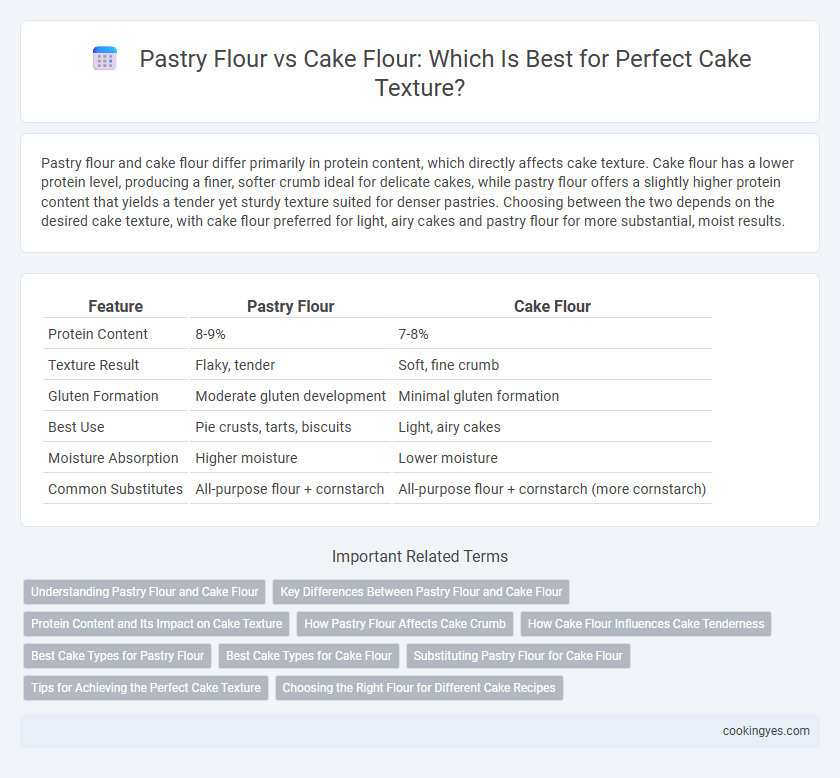Pastry flour and cake flour differ primarily in protein content, which directly affects cake texture. Cake flour has a lower protein level, producing a finer, softer crumb ideal for delicate cakes, while pastry flour offers a slightly higher protein content that yields a tender yet sturdy texture suited for denser pastries. Choosing between the two depends on the desired cake texture, with cake flour preferred for light, airy cakes and pastry flour for more substantial, moist results.
Table of Comparison
| Feature | Pastry Flour | Cake Flour |
|---|---|---|
| Protein Content | 8-9% | 7-8% |
| Texture Result | Flaky, tender | Soft, fine crumb |
| Gluten Formation | Moderate gluten development | Minimal gluten formation |
| Best Use | Pie crusts, tarts, biscuits | Light, airy cakes |
| Moisture Absorption | Higher moisture | Lower moisture |
| Common Substitutes | All-purpose flour + cornstarch | All-purpose flour + cornstarch (more cornstarch) |
Understanding Pastry Flour and Cake Flour
Pastry flour contains about 8-9% protein, offering a balance between tenderness and structure, making it ideal for flaky pastries and slightly denser cakes. Cake flour has a lower protein content of approximately 7-8%, resulting in a finer, softer crumb and lighter texture perfect for delicate cakes. Understanding the protein content difference helps bakers choose the right flour to achieve the desired cake texture, with pastry flour providing more chew and cake flour delivering maximum tenderness.
Key Differences Between Pastry Flour and Cake Flour
Pastry flour and cake flour differ primarily in protein content, with pastry flour containing around 8-9% protein and cake flour approximately 7-8%. This variation affects cake texture, as pastry flour produces a tender yet slightly denser crumb, while cake flour yields a finer, softer, and lighter texture ideal for delicate cakes. The lower protein content and finer milling of cake flour contribute to better gluten development control, enhancing cake lightness and moisture retention.
Protein Content and Its Impact on Cake Texture
Pastry flour contains about 8-9% protein, providing a balance that yields tender yet slightly sturdy cakes, while cake flour has a lower protein content of around 7-8%, resulting in a finer, softer crumb ideal for delicate cakes. The lower protein in cake flour reduces gluten formation, producing a lighter, fluffier texture, whereas the higher protein in pastry flour forms more gluten, offering a bit more structure and chew. Choosing between pastry and cake flour directly influences cake moisture, tenderness, and overall crumb softness based on their protein content and gluten development.
How Pastry Flour Affects Cake Crumb
Pastry flour contains a moderate protein content, typically around 8-9%, which creates a tender yet slightly denser cake crumb compared to cake flour. Its balanced gluten development results in a crumb that is moist with a fine structure, offering a subtle chewiness while still maintaining softness. Using pastry flour enhances the cake's texture by providing more structure without sacrificing tenderness, ideal for cakes that benefit from a more substantial crumb.
How Cake Flour Influences Cake Tenderness
Cake flour, with its lower protein content and finer texture compared to pastry flour, creates a softer, more tender crumb in cakes by producing less gluten. This reduced gluten development results in a delicate, airy structure ideal for light, fluffy cakes like chiffon or sponge. Using cake flour enhances moisture retention, contributing to a moist and tender bite that defines high-quality cake texture.
Best Cake Types for Pastry Flour
Pastry flour, with its moderate protein content of around 8-9%, provides a tender yet slightly sturdy crumb ideal for flakier and denser cakes like pound cakes, coffee cakes, and American-style layer cakes. It strikes a balance between cake flour's softness and all-purpose flour's strength, making it suitable for recipes that require a delicate but not overly fine texture. Cakes that benefit most from pastry flour are those where a subtle chewiness and moist, rich texture are desired rather than an ultra-light or airy crumb.
Best Cake Types for Cake Flour
Cake flour, with its low protein content around 7-8%, produces a tender, fine crumb ideal for delicate cakes like angel food, chiffon, and sponge cakes. Its finely milled texture absorbs moisture well, creating a soft, moist bite that enhances airy and light cake varieties. Using cake flour in recipes requiring a fluffy and fragile structure ensures optimal softness and rise compared to pastry or all-purpose flours.
Substituting Pastry Flour for Cake Flour
Pastry flour contains a higher protein content (around 8-9%) compared to cake flour (about 7-8%), which affects the cake's tenderness and crumb structure. Substituting pastry flour for cake flour may result in a slightly denser and less delicate cake texture due to increased gluten development. To achieve a lighter cake, reduce the protein impact by combining pastry flour with cornstarch as a partial substitute when cake flour is unavailable.
Tips for Achieving the Perfect Cake Texture
Pastry flour and cake flour each affect cake texture differently due to their protein content, with cake flour typically having 7-8% protein for a softer, tender crumb, while pastry flour has around 9-10% protein, yielding a slightly denser texture. To achieve the perfect cake texture, use cake flour for delicate, light cakes and pastry flour for more structured cakes like pound or tea cakes. Sifting flour before measuring and avoiding overmixing ensures even crumb and prevents toughness regardless of flour choice.
Choosing the Right Flour for Different Cake Recipes
Pastry flour contains a moderate protein content of about 8-9%, making it ideal for tender yet slightly denser cakes like pound cakes and coffee cakes, where a delicate crumb is desired without excessive fluffiness. Cake flour has a lower protein content, around 7-8%, resulting in a finer, softer texture perfect for light and airy cakes such as chiffon and sponge cakes. Selecting pastry flour enhances structure and moisture retention in richer recipes, while cake flour produces a more tender, melt-in-your-mouth crumb in lighter, more delicate cakes.
Pastry Flour vs Cake Flour for cake texture Infographic

 cookingyes.com
cookingyes.com